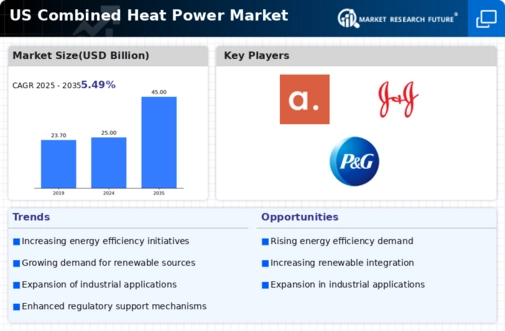The US Combined Heat Power (CHP) Market exhibits a dynamic landscape characterized by various players competing to provide efficient energy solutions that capitalize on the dual utility of power and thermal energy generation. The market has seen a growing interest in cogeneration systems due to the increasing emphasis on energy efficiency, lower carbon emissions, and the adoption of sustainability practices among industries. This competitive environment drives innovation and technological advancements, resulting in improved CHP systems that offer enhanced performance and reliability.
Networking and collaboration among manufacturers, energy service companies, and regulatory bodies contribute to a thriving ecosystem, encouraging investments in research and development as well as the expansion of infrastructure in the energy sector.
Babcock and Wilcox is a notable player in the US Combined Heat Power Market, showcasing strengths in delivering innovative energy solutions tailored to meet the specific needs of its clients. The company has a robust presence in the industry, capitalizing on its extensive experience in boiler and energy technology to enhance the performance and efficiency of CHP systems. Babcock and Wilcox focus on developing high-efficiency systems that support industrial and commercial sectors, playing a critical role in energy optimization. The company’s commitment to engineering excellence and sustainability positions it as a strong competitor in the market.
Leveraging its historical expertise in thermal energy, Babcock and Wilcox continues to adapt to market trends, advancing its product offerings and setting industry standards.
Mitsubishi Power has established a prominent foothold in the US Combined Heat Power Market, characterized by its advanced technological solutions and product portfolio tailored to cogeneration applications. As a key player in the energy sector, Mitsubishi Power focuses on integrating renewable energy sources with its high-efficiency gas turbines and heat recovery steam generators. Its strengths lie in the innovative solutions it offers, which emphasize reliability and sustainability, catering specifically to the needs of US customers. Additionally, Mitsubishi Power actively pursues partnerships and collaborations to enhance its market access and capabilities.
The company has engaged in several strategic mergers and acquisitions to bolster its technological base and expand its portfolio of products and services, targeting industrial and utility sectors that seek efficient energy generation systems. This strategic positioning, coupled with a commitment to driving energy transition initiatives, strengthens Mitsubishi Power's competitive edge in the US CHP market.














Leave a Comment